Difference And Diversity In Early Years Settings - Essay
VerifiedAdded on 2021/05/27
|9
|2344
|38
AI Summary
Contribute Materials
Your contribution can guide someone’s learning journey. Share your
documents today.
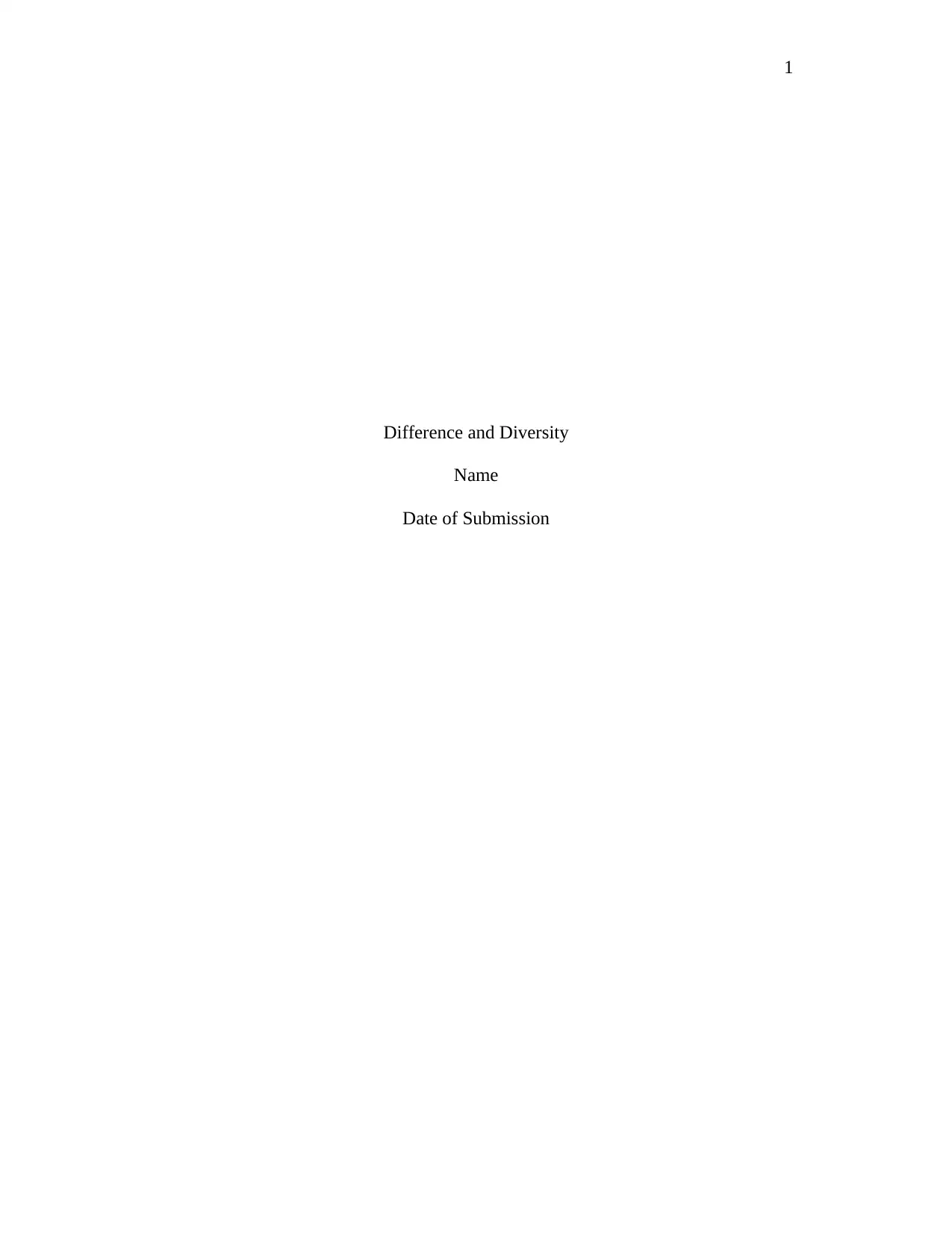
1
Difference and Diversity
Name
Date of Submission
Difference and Diversity
Name
Date of Submission
Secure Best Marks with AI Grader
Need help grading? Try our AI Grader for instant feedback on your assignments.
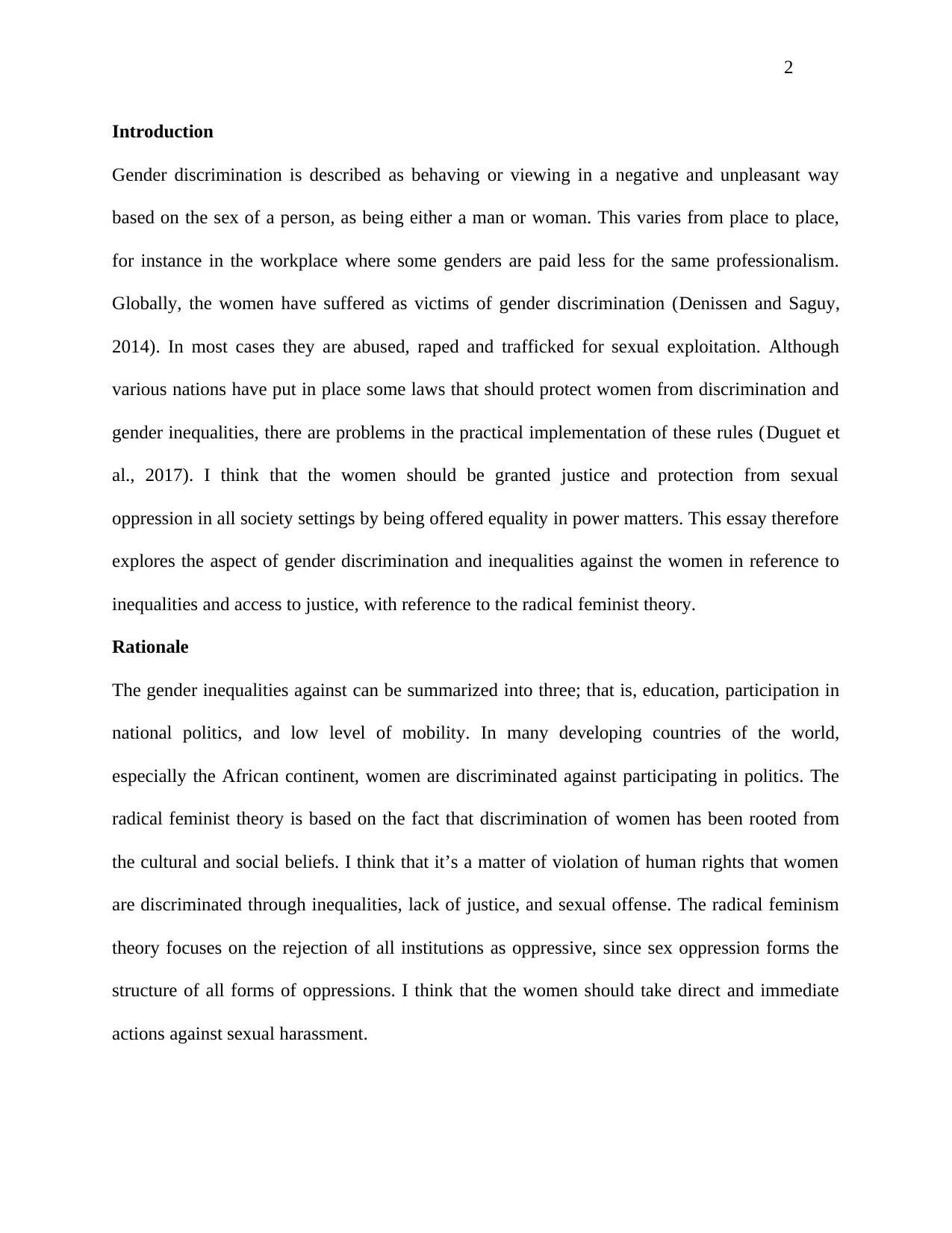
2
Introduction
Gender discrimination is described as behaving or viewing in a negative and unpleasant way
based on the sex of a person, as being either a man or woman. This varies from place to place,
for instance in the workplace where some genders are paid less for the same professionalism.
Globally, the women have suffered as victims of gender discrimination (Denissen and Saguy,
2014). In most cases they are abused, raped and trafficked for sexual exploitation. Although
various nations have put in place some laws that should protect women from discrimination and
gender inequalities, there are problems in the practical implementation of these rules (Duguet et
al., 2017). I think that the women should be granted justice and protection from sexual
oppression in all society settings by being offered equality in power matters. This essay therefore
explores the aspect of gender discrimination and inequalities against the women in reference to
inequalities and access to justice, with reference to the radical feminist theory.
Rationale
The gender inequalities against can be summarized into three; that is, education, participation in
national politics, and low level of mobility. In many developing countries of the world,
especially the African continent, women are discriminated against participating in politics. The
radical feminist theory is based on the fact that discrimination of women has been rooted from
the cultural and social beliefs. I think that it’s a matter of violation of human rights that women
are discriminated through inequalities, lack of justice, and sexual offense. The radical feminism
theory focuses on the rejection of all institutions as oppressive, since sex oppression forms the
structure of all forms of oppressions. I think that the women should take direct and immediate
actions against sexual harassment.
Introduction
Gender discrimination is described as behaving or viewing in a negative and unpleasant way
based on the sex of a person, as being either a man or woman. This varies from place to place,
for instance in the workplace where some genders are paid less for the same professionalism.
Globally, the women have suffered as victims of gender discrimination (Denissen and Saguy,
2014). In most cases they are abused, raped and trafficked for sexual exploitation. Although
various nations have put in place some laws that should protect women from discrimination and
gender inequalities, there are problems in the practical implementation of these rules (Duguet et
al., 2017). I think that the women should be granted justice and protection from sexual
oppression in all society settings by being offered equality in power matters. This essay therefore
explores the aspect of gender discrimination and inequalities against the women in reference to
inequalities and access to justice, with reference to the radical feminist theory.
Rationale
The gender inequalities against can be summarized into three; that is, education, participation in
national politics, and low level of mobility. In many developing countries of the world,
especially the African continent, women are discriminated against participating in politics. The
radical feminist theory is based on the fact that discrimination of women has been rooted from
the cultural and social beliefs. I think that it’s a matter of violation of human rights that women
are discriminated through inequalities, lack of justice, and sexual offense. The radical feminism
theory focuses on the rejection of all institutions as oppressive, since sex oppression forms the
structure of all forms of oppressions. I think that the women should take direct and immediate
actions against sexual harassment.
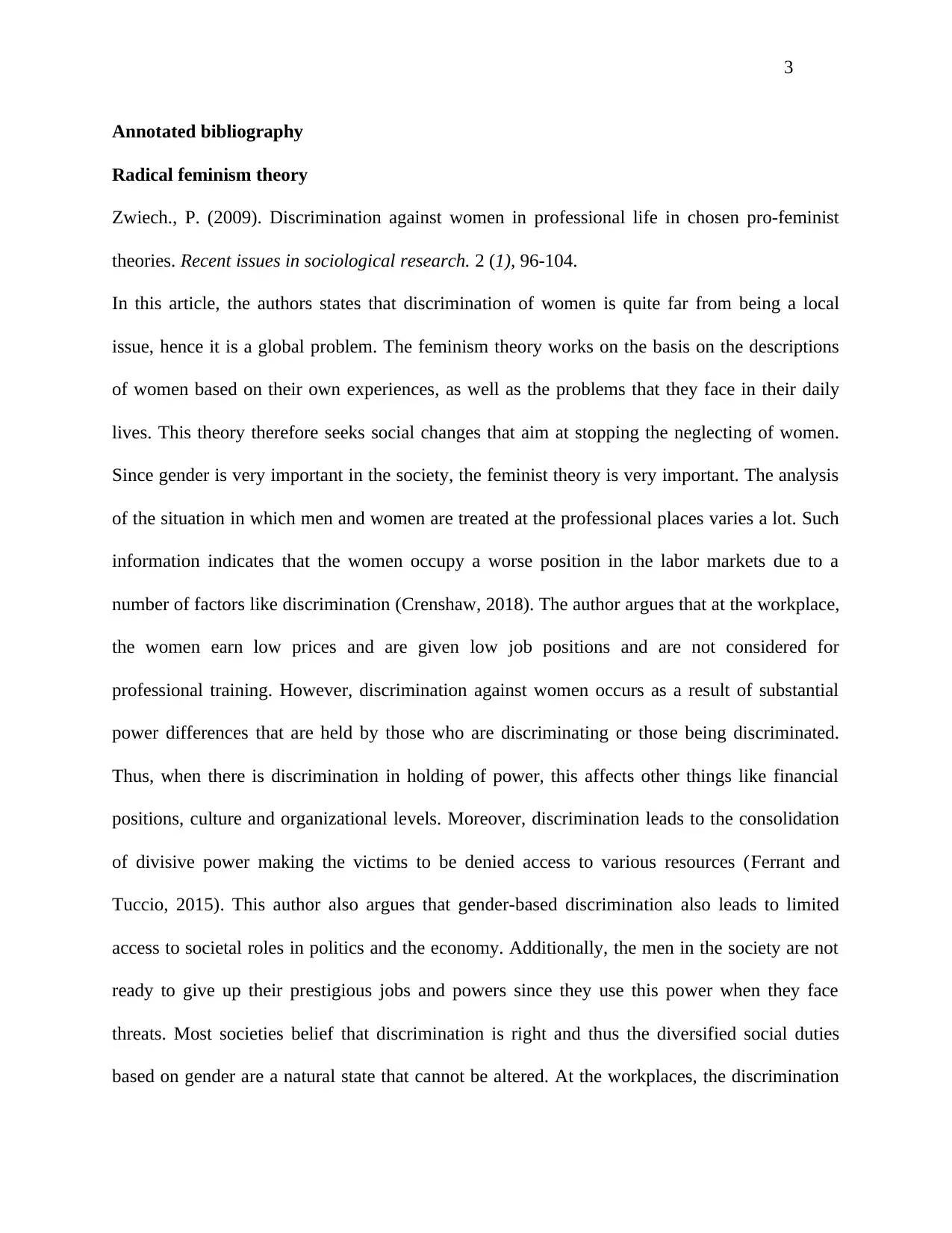
3
Annotated bibliography
Radical feminism theory
Zwiech., P. (2009). Discrimination against women in professional life in chosen pro-feminist
theories. Recent issues in sociological research. 2 (1), 96-104.
In this article, the authors states that discrimination of women is quite far from being a local
issue, hence it is a global problem. The feminism theory works on the basis on the descriptions
of women based on their own experiences, as well as the problems that they face in their daily
lives. This theory therefore seeks social changes that aim at stopping the neglecting of women.
Since gender is very important in the society, the feminist theory is very important. The analysis
of the situation in which men and women are treated at the professional places varies a lot. Such
information indicates that the women occupy a worse position in the labor markets due to a
number of factors like discrimination (Crenshaw, 2018). The author argues that at the workplace,
the women earn low prices and are given low job positions and are not considered for
professional training. However, discrimination against women occurs as a result of substantial
power differences that are held by those who are discriminating or those being discriminated.
Thus, when there is discrimination in holding of power, this affects other things like financial
positions, culture and organizational levels. Moreover, discrimination leads to the consolidation
of divisive power making the victims to be denied access to various resources (Ferrant and
Tuccio, 2015). This author also argues that gender-based discrimination also leads to limited
access to societal roles in politics and the economy. Additionally, the men in the society are not
ready to give up their prestigious jobs and powers since they use this power when they face
threats. Most societies belief that discrimination is right and thus the diversified social duties
based on gender are a natural state that cannot be altered. At the workplaces, the discrimination
Annotated bibliography
Radical feminism theory
Zwiech., P. (2009). Discrimination against women in professional life in chosen pro-feminist
theories. Recent issues in sociological research. 2 (1), 96-104.
In this article, the authors states that discrimination of women is quite far from being a local
issue, hence it is a global problem. The feminism theory works on the basis on the descriptions
of women based on their own experiences, as well as the problems that they face in their daily
lives. This theory therefore seeks social changes that aim at stopping the neglecting of women.
Since gender is very important in the society, the feminist theory is very important. The analysis
of the situation in which men and women are treated at the professional places varies a lot. Such
information indicates that the women occupy a worse position in the labor markets due to a
number of factors like discrimination (Crenshaw, 2018). The author argues that at the workplace,
the women earn low prices and are given low job positions and are not considered for
professional training. However, discrimination against women occurs as a result of substantial
power differences that are held by those who are discriminating or those being discriminated.
Thus, when there is discrimination in holding of power, this affects other things like financial
positions, culture and organizational levels. Moreover, discrimination leads to the consolidation
of divisive power making the victims to be denied access to various resources (Ferrant and
Tuccio, 2015). This author also argues that gender-based discrimination also leads to limited
access to societal roles in politics and the economy. Additionally, the men in the society are not
ready to give up their prestigious jobs and powers since they use this power when they face
threats. Most societies belief that discrimination is right and thus the diversified social duties
based on gender are a natural state that cannot be altered. At the workplaces, the discrimination
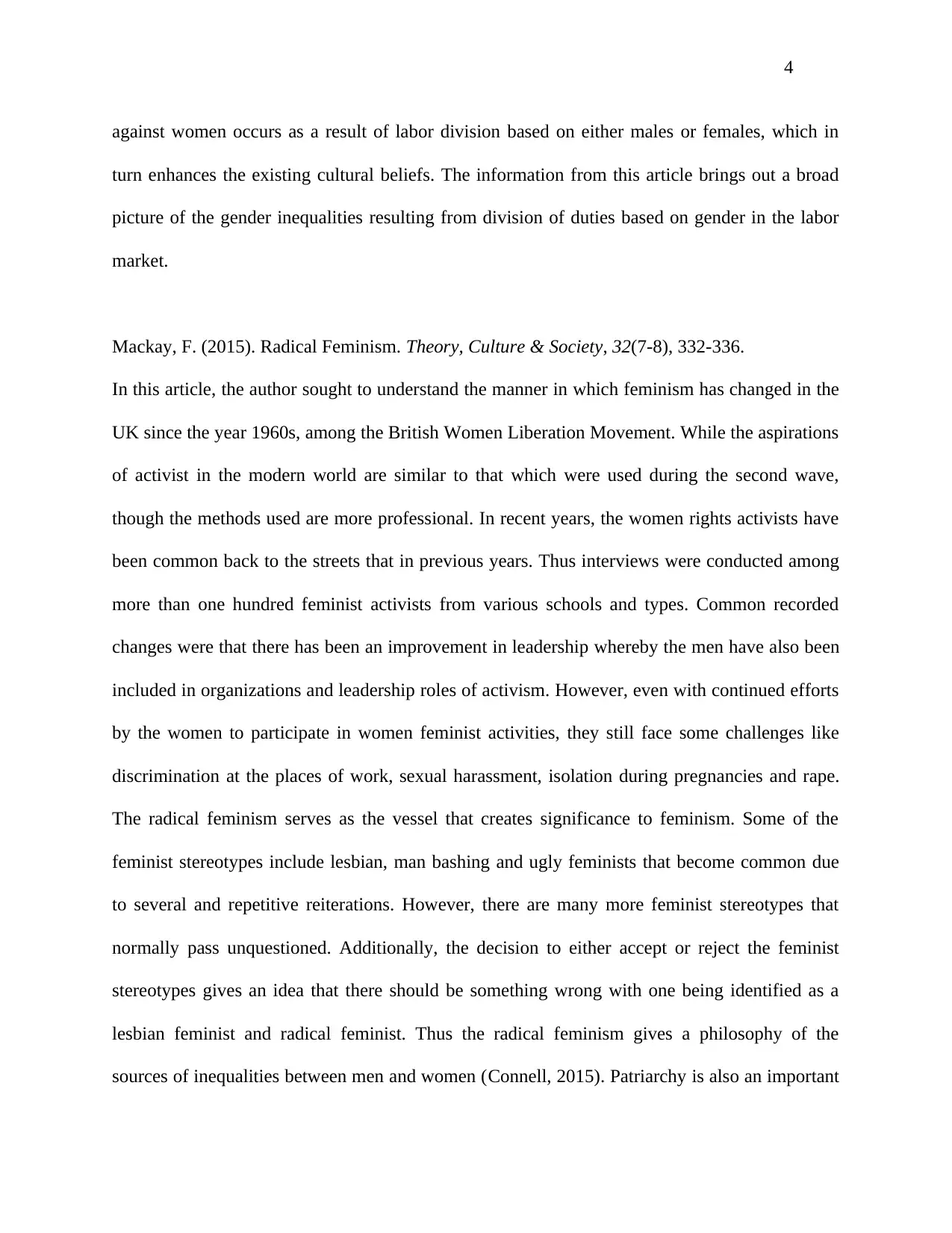
4
against women occurs as a result of labor division based on either males or females, which in
turn enhances the existing cultural beliefs. The information from this article brings out a broad
picture of the gender inequalities resulting from division of duties based on gender in the labor
market.
Mackay, F. (2015). Radical Feminism. Theory, Culture & Society, 32(7-8), 332-336.
In this article, the author sought to understand the manner in which feminism has changed in the
UK since the year 1960s, among the British Women Liberation Movement. While the aspirations
of activist in the modern world are similar to that which were used during the second wave,
though the methods used are more professional. In recent years, the women rights activists have
been common back to the streets that in previous years. Thus interviews were conducted among
more than one hundred feminist activists from various schools and types. Common recorded
changes were that there has been an improvement in leadership whereby the men have also been
included in organizations and leadership roles of activism. However, even with continued efforts
by the women to participate in women feminist activities, they still face some challenges like
discrimination at the places of work, sexual harassment, isolation during pregnancies and rape.
The radical feminism serves as the vessel that creates significance to feminism. Some of the
feminist stereotypes include lesbian, man bashing and ugly feminists that become common due
to several and repetitive reiterations. However, there are many more feminist stereotypes that
normally pass unquestioned. Additionally, the decision to either accept or reject the feminist
stereotypes gives an idea that there should be something wrong with one being identified as a
lesbian feminist and radical feminist. Thus the radical feminism gives a philosophy of the
sources of inequalities between men and women (Connell, 2015). Patriarchy is also an important
against women occurs as a result of labor division based on either males or females, which in
turn enhances the existing cultural beliefs. The information from this article brings out a broad
picture of the gender inequalities resulting from division of duties based on gender in the labor
market.
Mackay, F. (2015). Radical Feminism. Theory, Culture & Society, 32(7-8), 332-336.
In this article, the author sought to understand the manner in which feminism has changed in the
UK since the year 1960s, among the British Women Liberation Movement. While the aspirations
of activist in the modern world are similar to that which were used during the second wave,
though the methods used are more professional. In recent years, the women rights activists have
been common back to the streets that in previous years. Thus interviews were conducted among
more than one hundred feminist activists from various schools and types. Common recorded
changes were that there has been an improvement in leadership whereby the men have also been
included in organizations and leadership roles of activism. However, even with continued efforts
by the women to participate in women feminist activities, they still face some challenges like
discrimination at the places of work, sexual harassment, isolation during pregnancies and rape.
The radical feminism serves as the vessel that creates significance to feminism. Some of the
feminist stereotypes include lesbian, man bashing and ugly feminists that become common due
to several and repetitive reiterations. However, there are many more feminist stereotypes that
normally pass unquestioned. Additionally, the decision to either accept or reject the feminist
stereotypes gives an idea that there should be something wrong with one being identified as a
lesbian feminist and radical feminist. Thus the radical feminism gives a philosophy of the
sources of inequalities between men and women (Connell, 2015). Patriarchy is also an important
Secure Best Marks with AI Grader
Need help grading? Try our AI Grader for instant feedback on your assignments.

5
component which has been described in this article whereby the radical feminism views
patriarchy in form of division of rights and power privileges based on gender. Since radical
feminism and patriarchy are tied, the radical feminism opposes the social and political
organizations that are related to power based discrimination and inequalities on women in the
society. This article enables me to link the concept of radical feminism in the current life where
the women are still appressed despite the rise of women right activist groups.
Discrimination in women
Noronha, S. D., & Aithal, P. S. (2016). Glass Ceiling-A Silent Barrier for Women in Highly
Advanced and Humanistic Society. IRA-International Journal of Management & Social
Sciences,5 (3), 455-466, 2016
In this article, the authors indicate the gender discrimination that exits in the context of advanced
and humanistic society. In this case, the Indian society is presented as a country which has many
educated people and hence adopts gender equity policies. This has provided equal opportunities
for both men and women in the economic activities based on their professional qualifications.
Additionally, India is a country which has a highly competitive economy with advanced adoption
of technological methods that leads to career growth for men and women. Considering power,
the Indian society has also given men and women equal opportunities to hold leadership
positions. As a result, for a number of years, women have been recognized in Indian society in
occupying top leadership positions. In this article however, although there were significant
number of women in top positions, there were some significant doubts concerning whether there
were any women occupying the management positions. The importance of this concern is
because most decision making process in organizations takes place at the executive level. This is
an indication that in nearly all societies, there still exist some barriers to women in advancing
component which has been described in this article whereby the radical feminism views
patriarchy in form of division of rights and power privileges based on gender. Since radical
feminism and patriarchy are tied, the radical feminism opposes the social and political
organizations that are related to power based discrimination and inequalities on women in the
society. This article enables me to link the concept of radical feminism in the current life where
the women are still appressed despite the rise of women right activist groups.
Discrimination in women
Noronha, S. D., & Aithal, P. S. (2016). Glass Ceiling-A Silent Barrier for Women in Highly
Advanced and Humanistic Society. IRA-International Journal of Management & Social
Sciences,5 (3), 455-466, 2016
In this article, the authors indicate the gender discrimination that exits in the context of advanced
and humanistic society. In this case, the Indian society is presented as a country which has many
educated people and hence adopts gender equity policies. This has provided equal opportunities
for both men and women in the economic activities based on their professional qualifications.
Additionally, India is a country which has a highly competitive economy with advanced adoption
of technological methods that leads to career growth for men and women. Considering power,
the Indian society has also given men and women equal opportunities to hold leadership
positions. As a result, for a number of years, women have been recognized in Indian society in
occupying top leadership positions. In this article however, although there were significant
number of women in top positions, there were some significant doubts concerning whether there
were any women occupying the management positions. The importance of this concern is
because most decision making process in organizations takes place at the executive level. This is
an indication that in nearly all societies, there still exist some barriers to women in advancing
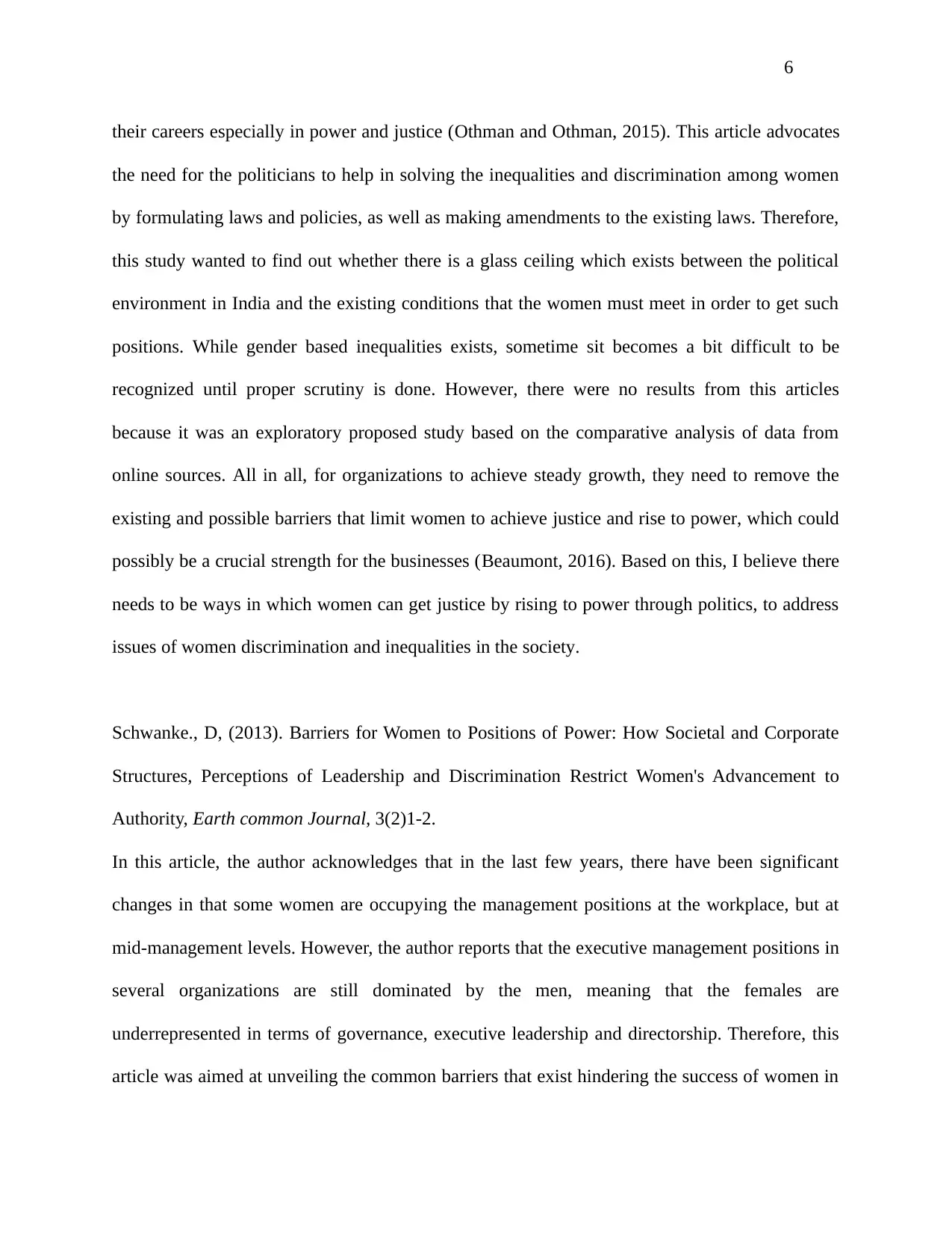
6
their careers especially in power and justice (Othman and Othman, 2015). This article advocates
the need for the politicians to help in solving the inequalities and discrimination among women
by formulating laws and policies, as well as making amendments to the existing laws. Therefore,
this study wanted to find out whether there is a glass ceiling which exists between the political
environment in India and the existing conditions that the women must meet in order to get such
positions. While gender based inequalities exists, sometime sit becomes a bit difficult to be
recognized until proper scrutiny is done. However, there were no results from this articles
because it was an exploratory proposed study based on the comparative analysis of data from
online sources. All in all, for organizations to achieve steady growth, they need to remove the
existing and possible barriers that limit women to achieve justice and rise to power, which could
possibly be a crucial strength for the businesses (Beaumont, 2016). Based on this, I believe there
needs to be ways in which women can get justice by rising to power through politics, to address
issues of women discrimination and inequalities in the society.
Schwanke., D, (2013). Barriers for Women to Positions of Power: How Societal and Corporate
Structures, Perceptions of Leadership and Discrimination Restrict Women's Advancement to
Authority, Earth common Journal, 3(2)1-2.
In this article, the author acknowledges that in the last few years, there have been significant
changes in that some women are occupying the management positions at the workplace, but at
mid-management levels. However, the author reports that the executive management positions in
several organizations are still dominated by the men, meaning that the females are
underrepresented in terms of governance, executive leadership and directorship. Therefore, this
article was aimed at unveiling the common barriers that exist hindering the success of women in
their careers especially in power and justice (Othman and Othman, 2015). This article advocates
the need for the politicians to help in solving the inequalities and discrimination among women
by formulating laws and policies, as well as making amendments to the existing laws. Therefore,
this study wanted to find out whether there is a glass ceiling which exists between the political
environment in India and the existing conditions that the women must meet in order to get such
positions. While gender based inequalities exists, sometime sit becomes a bit difficult to be
recognized until proper scrutiny is done. However, there were no results from this articles
because it was an exploratory proposed study based on the comparative analysis of data from
online sources. All in all, for organizations to achieve steady growth, they need to remove the
existing and possible barriers that limit women to achieve justice and rise to power, which could
possibly be a crucial strength for the businesses (Beaumont, 2016). Based on this, I believe there
needs to be ways in which women can get justice by rising to power through politics, to address
issues of women discrimination and inequalities in the society.
Schwanke., D, (2013). Barriers for Women to Positions of Power: How Societal and Corporate
Structures, Perceptions of Leadership and Discrimination Restrict Women's Advancement to
Authority, Earth common Journal, 3(2)1-2.
In this article, the author acknowledges that in the last few years, there have been significant
changes in that some women are occupying the management positions at the workplace, but at
mid-management levels. However, the author reports that the executive management positions in
several organizations are still dominated by the men, meaning that the females are
underrepresented in terms of governance, executive leadership and directorship. Therefore, this
article was aimed at unveiling the common barriers that exist hindering the success of women in

7
businesses. Therefore, the women who want to occupy the powerful positions in organization
leadership duties need to understand both the internal as well as the external obstacles that they
are likely to meet. In this case, they need to overcome the problems of gender inequality to
achieve their dreams (Puhl et al., 2008). Organizations that allow women to rise to power
positions are likely to enjoy various societal, corporate and economic benefits as compared to
those who discriminate them. Therefore, the males need to devise ways of removing barriers of
encouraging equality for the women to get justice and rise to power. For women who occupy
more visible roles, they are stereotypes as role traps and that their management methods are
directive than collaborative. In the event that such women do not have any other female
colleagues occupying management positions, they may feel isolated. Such wrong stereotypes
alongside discrimination and gender based inequalities creates limits to the possible
opportunities that could be available for such women. I think the factors that form barriers to
women from getting power and being discriminated in the society should be addressed.
businesses. Therefore, the women who want to occupy the powerful positions in organization
leadership duties need to understand both the internal as well as the external obstacles that they
are likely to meet. In this case, they need to overcome the problems of gender inequality to
achieve their dreams (Puhl et al., 2008). Organizations that allow women to rise to power
positions are likely to enjoy various societal, corporate and economic benefits as compared to
those who discriminate them. Therefore, the males need to devise ways of removing barriers of
encouraging equality for the women to get justice and rise to power. For women who occupy
more visible roles, they are stereotypes as role traps and that their management methods are
directive than collaborative. In the event that such women do not have any other female
colleagues occupying management positions, they may feel isolated. Such wrong stereotypes
alongside discrimination and gender based inequalities creates limits to the possible
opportunities that could be available for such women. I think the factors that form barriers to
women from getting power and being discriminated in the society should be addressed.
Paraphrase This Document
Need a fresh take? Get an instant paraphrase of this document with our AI Paraphraser
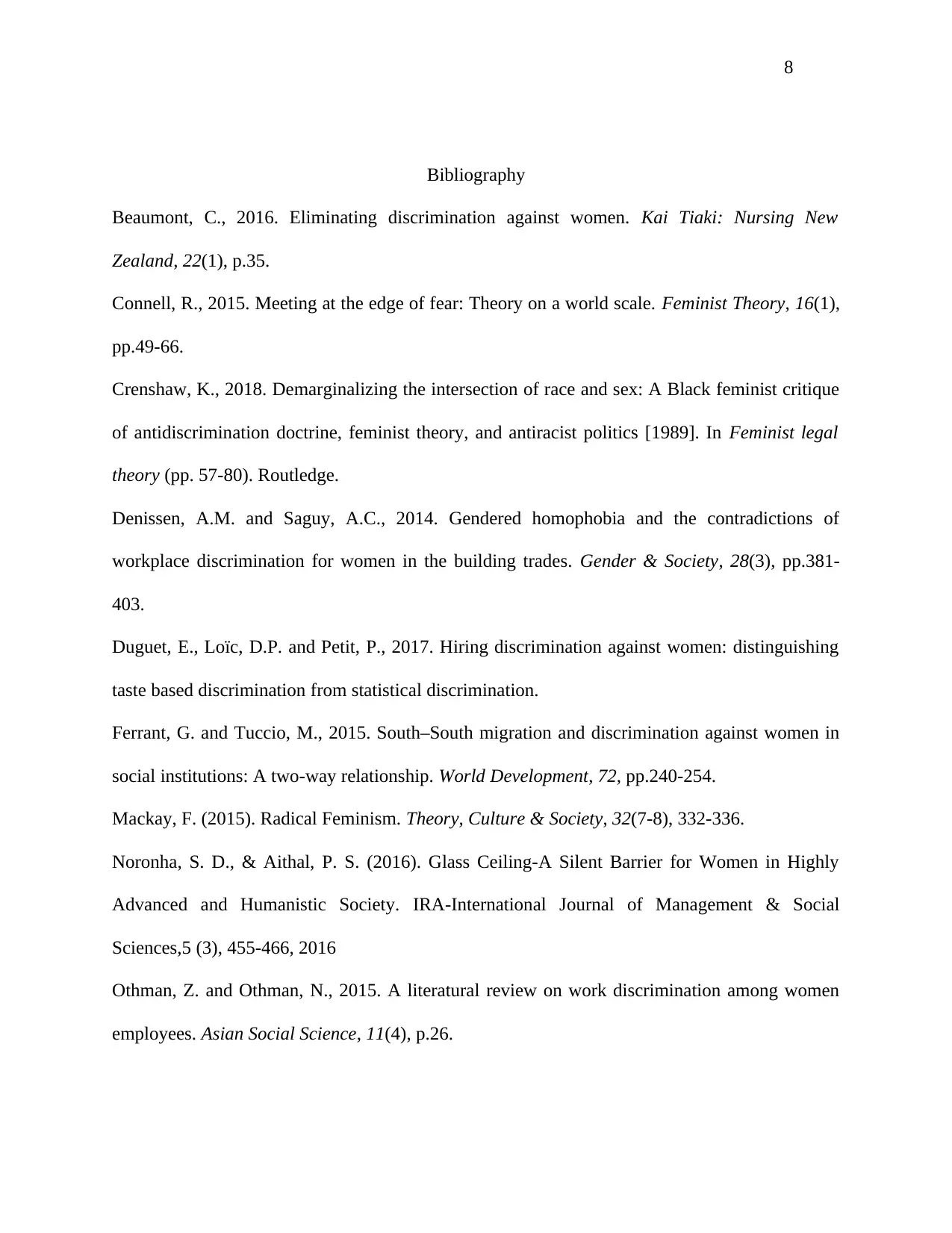
8
Bibliography
Beaumont, C., 2016. Eliminating discrimination against women. Kai Tiaki: Nursing New
Zealand, 22(1), p.35.
Connell, R., 2015. Meeting at the edge of fear: Theory on a world scale. Feminist Theory, 16(1),
pp.49-66.
Crenshaw, K., 2018. Demarginalizing the intersection of race and sex: A Black feminist critique
of antidiscrimination doctrine, feminist theory, and antiracist politics [1989]. In Feminist legal
theory (pp. 57-80). Routledge.
Denissen, A.M. and Saguy, A.C., 2014. Gendered homophobia and the contradictions of
workplace discrimination for women in the building trades. Gender & Society, 28(3), pp.381-
403.
Duguet, E., Loïc, D.P. and Petit, P., 2017. Hiring discrimination against women: distinguishing
taste based discrimination from statistical discrimination.
Ferrant, G. and Tuccio, M., 2015. South–South migration and discrimination against women in
social institutions: A two-way relationship. World Development, 72, pp.240-254.
Mackay, F. (2015). Radical Feminism. Theory, Culture & Society, 32(7-8), 332-336.
Noronha, S. D., & Aithal, P. S. (2016). Glass Ceiling-A Silent Barrier for Women in Highly
Advanced and Humanistic Society. IRA-International Journal of Management & Social
Sciences,5 (3), 455-466, 2016
Othman, Z. and Othman, N., 2015. A literatural review on work discrimination among women
employees. Asian Social Science, 11(4), p.26.
Bibliography
Beaumont, C., 2016. Eliminating discrimination against women. Kai Tiaki: Nursing New
Zealand, 22(1), p.35.
Connell, R., 2015. Meeting at the edge of fear: Theory on a world scale. Feminist Theory, 16(1),
pp.49-66.
Crenshaw, K., 2018. Demarginalizing the intersection of race and sex: A Black feminist critique
of antidiscrimination doctrine, feminist theory, and antiracist politics [1989]. In Feminist legal
theory (pp. 57-80). Routledge.
Denissen, A.M. and Saguy, A.C., 2014. Gendered homophobia and the contradictions of
workplace discrimination for women in the building trades. Gender & Society, 28(3), pp.381-
403.
Duguet, E., Loïc, D.P. and Petit, P., 2017. Hiring discrimination against women: distinguishing
taste based discrimination from statistical discrimination.
Ferrant, G. and Tuccio, M., 2015. South–South migration and discrimination against women in
social institutions: A two-way relationship. World Development, 72, pp.240-254.
Mackay, F. (2015). Radical Feminism. Theory, Culture & Society, 32(7-8), 332-336.
Noronha, S. D., & Aithal, P. S. (2016). Glass Ceiling-A Silent Barrier for Women in Highly
Advanced and Humanistic Society. IRA-International Journal of Management & Social
Sciences,5 (3), 455-466, 2016
Othman, Z. and Othman, N., 2015. A literatural review on work discrimination among women
employees. Asian Social Science, 11(4), p.26.
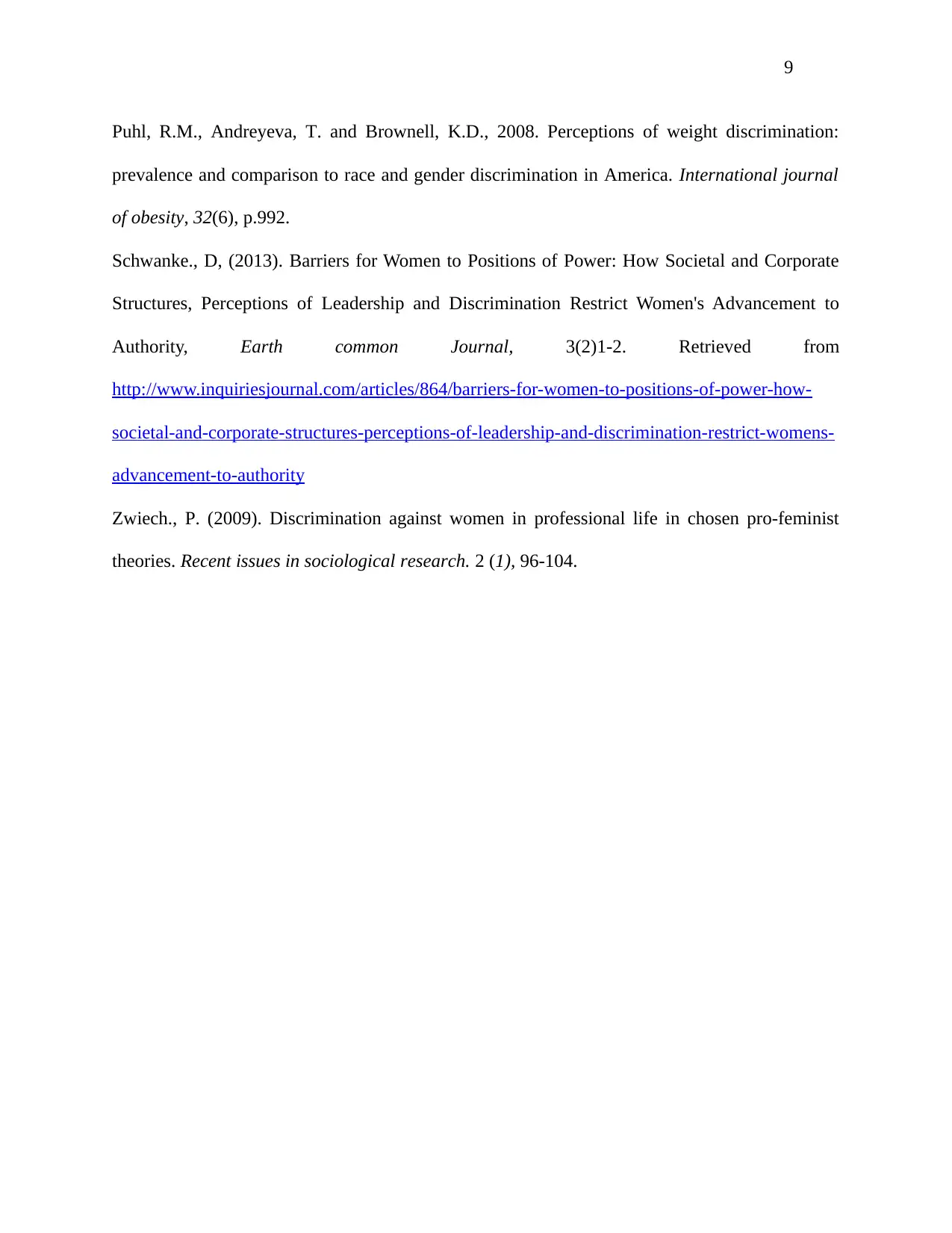
9
Puhl, R.M., Andreyeva, T. and Brownell, K.D., 2008. Perceptions of weight discrimination:
prevalence and comparison to race and gender discrimination in America. International journal
of obesity, 32(6), p.992.
Schwanke., D, (2013). Barriers for Women to Positions of Power: How Societal and Corporate
Structures, Perceptions of Leadership and Discrimination Restrict Women's Advancement to
Authority, Earth common Journal, 3(2)1-2. Retrieved from
http://www.inquiriesjournal.com/articles/864/barriers-for-women-to-positions-of-power-how-
societal-and-corporate-structures-perceptions-of-leadership-and-discrimination-restrict-womens-
advancement-to-authority
Zwiech., P. (2009). Discrimination against women in professional life in chosen pro-feminist
theories. Recent issues in sociological research. 2 (1), 96-104.
Puhl, R.M., Andreyeva, T. and Brownell, K.D., 2008. Perceptions of weight discrimination:
prevalence and comparison to race and gender discrimination in America. International journal
of obesity, 32(6), p.992.
Schwanke., D, (2013). Barriers for Women to Positions of Power: How Societal and Corporate
Structures, Perceptions of Leadership and Discrimination Restrict Women's Advancement to
Authority, Earth common Journal, 3(2)1-2. Retrieved from
http://www.inquiriesjournal.com/articles/864/barriers-for-women-to-positions-of-power-how-
societal-and-corporate-structures-perceptions-of-leadership-and-discrimination-restrict-womens-
advancement-to-authority
Zwiech., P. (2009). Discrimination against women in professional life in chosen pro-feminist
theories. Recent issues in sociological research. 2 (1), 96-104.
1 out of 9
Related Documents
Your All-in-One AI-Powered Toolkit for Academic Success.
+13062052269
info@desklib.com
Available 24*7 on WhatsApp / Email
![[object Object]](/_next/static/media/star-bottom.7253800d.svg)
Unlock your academic potential
© 2024 | Zucol Services PVT LTD | All rights reserved.





